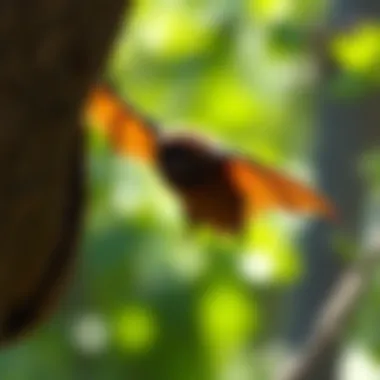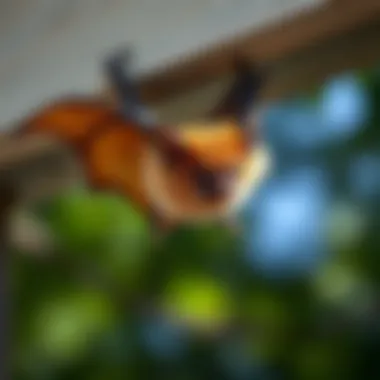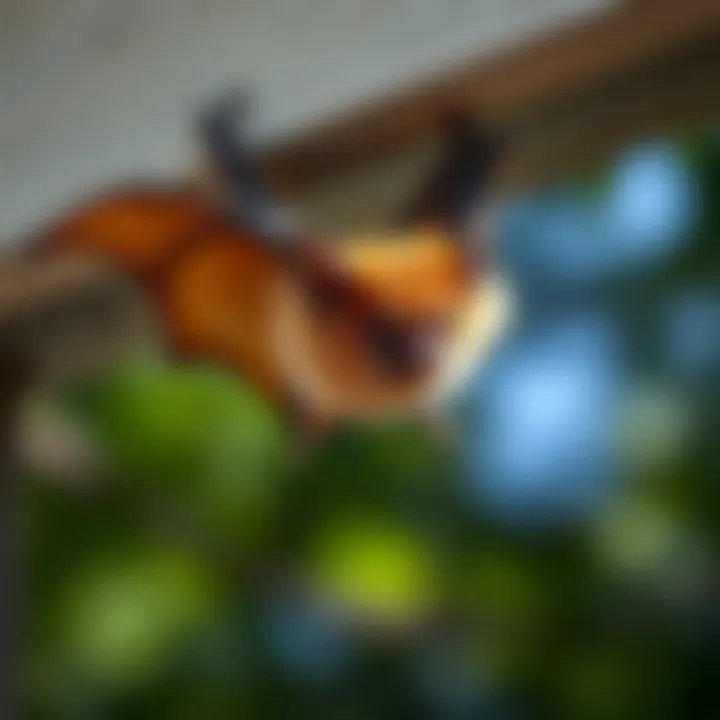Home Remedies to Effectively Deter Bats Naturally


Intro
Bats often evoke mixed feelings among homeowners. While they play essential roles in our ecosystem, such as controlling insect populations, their presence around homes can be quite troublesome. Oftentimes, folks find themselves searching for ways to keep these creatures at bay. This article explores a variety of home remedies that can help in deterring bats, unraveling practical solutions that marry efficiency with ecological mindfulness.
Understanding bats' behavior and their habitats can provide essential insights into how to manage their presence. This guide aims to equip homeowners with eco-friendly and non-invasive techniques that respect both human living spaces and the essential roles that bats play within the environment.
Understanding Pests
Definition of Pests
Pests are often defined as organisms that cause damage or nuisance to people, crops, or their living spaces. In the case of bats, while they might not directly cause harm in the same way that certain insects do, their droppings and presence can create hygiene concerns. They tend to roost in attics or under eaves, and can introduce unwanted odors and create unsanitary conditions.
Importance of Pest Identification
Identifying the specific type of pest is paramount. In dealing with bats, it's essential to recognize that not all species are harmful. For instance, the Little Brown Bat is relatively harmless and beneficial as it consumes vast amounts of insects. Knowing what kind of bats are frequenting your home can help in choosing the right strategies to manage them efficiently.
Prevention Techniques
Home and Garden Preventative Measures
Effective bat management begins with preventative measures around the home. Simple home modifications can deter bats from nesting or roosting:
- Seal Entry Points: Bats can squeeze through surprisingly small openings. Inspect the home for cracks and holes, particularly around rooflines, eaves, and attics, and seal them properly.
- Install Screens: Use fine mesh screens on windows and vents to prevent bats from entering without restricting airflow.
- Maintain Gardens: Keeping trees and shrubs trimmed back can limit places for bats to roost. Planting certain flowers may deter them, as well. Opt for flowering plants that are not attractive to insects, as bats tend to follow their food source.
Seasonal Prevention Tips
Bats are more active during certain times of the year, particularly in spring and summer. Implementing proactive measures during these seasons can be crucial:
- Before Spring: In late winter, inspect and repair potential entry points. This preparation can discourage bats from seeking shelter inside come warmer months.
- During Summer: If bats are found in the home, it's best to contact a local wildlife specialist to ensure safe removal and exclusion without harming the animals.
Eco-Friendly Pest Control Solutions
Overview of Sustainable Practices
The approach to managing bats should respect biodiversity and aim for sustainable practices. Non-lethal methods consider the well-being of both bats and the environment they share with humans. Incorporating natural deterrents can be a win-win for all involved.
Natural Remedies and Their Effectiveness
There are several natural remedies homeowners have found effective:
- Ultrasonic Devices: These emit high-frequency sounds that are unpleasant for bats but undetectable to human ears.
- Essential Oils: Sprays made from peppermint, lavender, or eucalyptus can create a fragrant barrier that bats tend to avoid. Mixing a few drops of these oils with water and spraying around entry points may aid in deterring them.
- Bright Lights: Bats prefer dark, secluded spaces; thus, strategically placing bright lights in commonly frequented areas can be an effective deterrent.
"Knowledge of bat behavior can illuminate effective ways to coexist peacefully with these essential creatures. By employing the right remedies, we can ensure both comfort in our homes and the protection of our local ecosystems."
By combining knowledge of bat behavior with eco-friendly techniques, homeowners can create an atmosphere that's unwelcoming to bats, while still appreciating their crucial ecological role.
Understanding Bat Behavior
Understanding the behavior of bats is crucial for effective management when it comes to keeping them away from homes and outdoor areas. Bats, often misunderstood and mischaracterized, play vital roles in ecosystems, such as pollinating plants and controlling insect populations. However, conflicts arise when they choose human dwellings as roosting sites. Knowing why bats are drawn to certain places can equip homeowners with tools to deter them effectively without resorting to harmful methods.
Why Bats Enter Homes
Bats typically enter homes for a few main reasons. First off, the temperature stability and shelter provided by human structures can be quite appealing, especially during extreme weather conditions. Bats are often in search of cozy places to roost, and your attic or shed could fit the bill perfectly. Additionally, they seek secluded spots to raise their young safely, away from potential predators.
Many might not realize, but food sources can also play a significant role. If your area has high insect populations, particularly mosquitoes or moths, it can attract bats to nearby structures. They are natural pest controllers, so when they see abundant prey, hitching a ride in your attic may seem advantageous.
"Bats are like uninvited guests, cozying up in the attic while you’d rather they stay clear!"
Common Bat Species in Residential Areas
Knowing the specific species of bats that reside in your locality should be part of your strategy. For instance, the Little Brown Bat, known for its small size and abundant population, often roosts in buildings. This species is particularly common in North America, thriving in urban environments. Then there’s the Big Brown Bat, which is slightly larger and also enjoys the comfort of civilization, often found in attics or behind shingles.
Another frequent visitor is the Mexican Free-tailed Bat that, unlike other species, often roosts in colonies that can be substantial in size. Their feeding habits center on open spaces, frequently leading them to suburban areas where food sources are plenty.
Here’s a brief overview of some common residents:
- Little Brown Bat: Prefers buildings and can be found in large numbers.
- Big Brown Bat: Known for its adaptability, it likes the nooks and crannies of homes.
- Mexican Free-tailed Bat: Often found in colonies, frequents areas with abundant food sources.


Familiarizing yourself with these species doesn't just prepare you to deal with their presence; it can bolster your understanding of their habits and preferences, important for implementing effective deterring measures.
The Importance of Non-Lethal Deterrents
Keeping bats at bay has become significant for many homeowners, given the delicate balance of maintaining an environment that’s comfortable and safe. It's not just about pushing these flying mammals out; it’s essential to do so in a way that doesn’t harm them. When discussing bat deterrence, the importance of non-lethal methods emerges as a cornerstone of humane pest management strategies. Bats play crucial roles in ecosystems, such as insect control and pollination. Many regions consider them valuable partners in maintaining healthy gardens and crops. Thus, adopting non-lethal measures ensures a symbiosis with wildlife, rather than a battle against it.
These methods also reflect broader ethical considerations. Residents today are generally more aware of animal rights and ecological sustainability. So, implementing strategies that prioritize non-lethal solutions not only reflects a homeowner’s values but also contributes to the conservation of bat populations. Lawmakers in numerous areas have even put laws in place prohibiting the killing or harming of bats, indicating the urgency and relevance of finding more humane approaches.
In addition to being ethical, non-lethal deterrents typically come with a slew of benefits. They often prove to be cost-effective, simple to implement, and carry little to no risk of side effects affecting other wildlife, pets, or the environment. The essence of these solutions is not merely to drive bats away but to effectively dissuade them from making your home their dwelling without resorting to harm.
By focusing on humane methods, homeowners create an atmosphere that promotes peaceful coexistence. Successful deterrent techniques can help alleviate the fear of bats while opening the door to educational opportunities regarding the unique value of these creatures.
"In the grander scheme, treating wildlife with consideration leads to healthier environments and communities."
Thus, the emphasis on non-lethal deterrents aligns with ethical standards, public policies, and sensible wildlife management.
Ethical Considerations
When deciding how to handle bats invading one��’s home, ethical considerations should be at the forefront. The narrative of pest management has dramatically shifted in recent years, moving towards solutions that respect wildlife. Bats, like all creatures, have their roles, and many can be considered endangered or threatened.
By choosing humane approaches, you reflect a commitment not just to your comfort but also to ecological well-being. For instance, simply excluding bats from your attic space or employing natural deterrents avoids the ethical pitfall of harming creatures that provide ecological benefits.
It’s also worth noting that some communities actively engage in conservation efforts regarding bats and other wildlife, adding an extra layer of responsibility for homeowners. A simple approach to bat management that centers on ethical considerations often leads to long-term solutions.
Benefits of Non-Invasive Solutions
Opting for non-invasive solutions to deter bats comes with numerous advantages. Firstly, there's peace of mind knowing that your approach is ethically sound and environmentally friendly. Many of these methods involve the use of natural repellents, such as peppermint oil or vinegar, which do not disturbe the natural ecosystems.
Moreover, non-invasive solutions tend to be less complicated and labor-intensive. You can implement them with relative ease, allowing homeowners to play an active role in their pest management. Further, using methods like garlic or sealing entry points can be significantly more affordable than contracted extermination services.
Another key benefit relates to safety; many lethal methods may inadvertently harm other wildlife, pets, or even humans if not handled properly. By prioritizing non-invasive techniques, you ensure the safety of your family and other creatures in your vicinity. This not only creates a safer environment but also fosters a sense of community responsibility.
In summary, focusing on humane and non-lethal solutions creates a win-win situation for everyone involved. Homeowners maintain safety and comfort while contributing to healthier ecosystems. Through ethical choices, they can create a haven not just for themselves but also for the wildlife that shares their space.
Natural Repellents for Bats
Natural repellents offer a non-invasive method to deter bats, making it crucial for homeowners seeking eco-friendly solutions. These alternatives not only reduce the number of bats around the property but also do so without harming them or using synthetic chemicals. Many strong scents are effective at repelling these nocturnal creatures, and some household items double as efficient deterrents. Understanding the mechanics of these repellents can empower individuals to take effective measures while maintaining harmony with local wildlife.
Essential Oils that Deter Bats
Essential oils are worth considering due to their potent aroma, which can create an unwelcoming environment for bats. The natural compounds in these oils often have multi-faceted benefits, from aromatherapy to pest control. Here are a few notable contenders:
Peppermint Oil
Peppermint oil stands out as a popular choice among essential oils for keeping bats away. Its strong, minty scent is known for being refreshing to humans but offensive to various pests, including bats. One key characteristic of peppermint oil is its high menthol content, which is particularly effective in deterring these animals. Homeowners can dilute the oil and spray it around potential entry points, creating a barrier that is both aromatic and unpleasant for bats.
However, one should be cautious with how frequently it's applied; excessive usage may lead to diminishing returns as the bats might adapt to it, rendering it less effective over time.
Lemongrass Oil
Lemongrass oil adds an interesting layer as a bat deterrent, favored for its citrusy freshness. This oil, derived from the lemongrass plant, contains citronella, notorious for repelling various pests, including mosquitoes. The unique feature of lemongrass oil is its dual function; it not only keeps bats at bay but also serves as an enjoyable aroma around the home. Mixing this oil with a carrier may help in prolonging its effects when used in sprays around common entryways. However, care should be taken not to apply it in areas where it may attract other insects.
Eucalyptus Oil
Eucalyptus oil is another heavy-hitter when it comes to natural repellents. Its sharp, camphor-like scent is something bats tend to avoid, making it an effective deterrent. This oil's key characteristic is its antibacterial properties, which adds an extra layer of benefit alongside its repellent qualities. Homeowners can concoct their own sprays by diluting eucalyptus oil in water and applying it liberally around problem areas.
On the downside, eucalyptus oil can be too potent, causing irritation in some instances if not used carefully. Hence, wearing protective gloves and goggles while mixing or spraying could avoid unexpected reactions.
Vinegar as a Deterrent
Vinegar, particularly white vinegar, works effectively as an inexpensive deterrent. Its strong odor can disrupt the bats' sense of smell, directing them away from potential roosting sites. For optimal results, homeowners can soak cotton balls in vinegar and place them around areas where bats are suspected to enter. Though vinegar is not a permanent fix, its availability and low cost make it a popular choice for temporary deterrence.
Garlic and its Efficacy
Garlic has long been touted for its pungent scent, which many pests find unappealing. When used to deter bats, crushed or minced garlic can serve as a potent repellent. Similar to vinegar, garlic can be made into a paste or solution and applied around entry points. One disadvantage, however, is the scent dissipates relatively quickly, requiring frequent reapplication to maintain its efficacy.
"Combining these natural repellents can create a robust defense against bats, ensuring that your living space remains uninviting while keeping the ecological balance in check."


By exploring these natural alternatives, homeowners can take steps toward a bat-free environment without resorting to harmful chemicals or invasive techniques. These methods showcase how simple household ingredients can stand up against unwanted wildlife, promoting both safety and sustainability.
Habitat Modification Techniques
Homeowners looking to keep bats at bay need to consider habitat modification techniques, which play a crucial role in making properties less attractive to these flying mammals. By altering the environment, residents can create a less welcoming space for bats, ultimately steering them away from their domiciles.
One notable aspect of habitat modification is that it goes beyond mere repellents or deterrents. Instead, it encourages homeowners to engage proactively with their living spaces. The main benefits of this approach include a reduction in bat activity and natural solutions that don’t harm the environment. Simple adjustments can make all the difference, often leading to lasting effects.
Sealing Entry Points
Identifying Common Entry Points
Identifying common entry points is a vital first step in thwarting bat invasions. These sneaky critters can find their way into surprising spots, often lurking in places that homeowners would least expect. Unsealed vents, gaps in roofing, eaves, and even cracks in walls can all serve as gateways for bats.
This aspect is beneficial because it encourages homeowners to assess their property closely. The key characteristic of this process is its simplicity. Regular inspections can reveal vulnerabilities, allowing for timely interventions. It’s an effective choice for this article as it emphasizes prevention over cure. If bats can’t enter, they can’t establish a home. However, this method does require diligence, as it necessitates ongoing monitoring of one’s property.
Effective Sealing Materials
Once common entry points are identified, effective sealing materials are integral to keeping bats out for good. Sealants such as expandable foam, caulk, and specialized bat-proofing materials can be used to close off entryways. Each of them brings unique features to the table; for instance, expandable foam can fill gaps of varying sizes and hardens to provide a solid barrier.
The significance of using high-quality sealing materials cannot be overstated. It ensures that even the most persistent bats cannot wiggle their way inside. This method proves beneficial as it is a long-term fix, minimizing the chances of recurrence. However, some materials might require specific application techniques or expertise to install properly, which could be a consideration for some homeowners.
Eliminating Food Sources
Reducing Insect Populations
Bats are often drawn to areas abundant with food, primarily insects. Reducing insect populations can dramatically decrease bat attraction to a property. For instance, homeowners might consider adjusting their landscaping or employing natural pest control methods to manage unwanted bugs effectively.
The advantage of this approach is twofold. It not only helps deter bats but also promotes better living conditions for residents. A property with fewer insects is a healthier one. This method is especially popular among environmentally conscious homeowners who aim to maintain a balance in their local ecosystem. Although the challenges include the need for persistent application and monitoring, the results can yield significant benefits.
Cleaning Up Attractants
Cleaning up attractants is just as vital as pest reduction. Things like poorly sealed garbage bins, pet food left outdoors, and standing water can become magnets for bats. This approach highlights practical and everyday actions homeowners can take to create a less inviting atmosphere for bats.
One notable characteristic of this method is its immediate impact. Often, a simple cleanup can bear fruit almost instantly. It’s a practical choice that requires minimal investment but promises significant returns. However, a consistent effort is necessary to maintain a clean environment, as lapses can quickly reverse the efforts made.
Enhancing Outdoor Lighting
To round out the habitat modification techniques, enhancing outdoor lighting plays a crucial part as well. Bats prefer dark environments where they can hunt and roost undisturbed. Installing bright lights, particularly motion sensor lights, can disrupt their comfort zones.
The key advantage of increasing outdoor lighting lies in its deterrent effect. With brighter areas, flies and other insects, which attract bats, become less accessible. Furthermore, motion sensor lights can further reinforce this deterrent' as they introduce an element of unpredictability. However, over-lighting may not be ideal for every property and could lead to increased energy expenses, so careful consideration is needed to balance effectiveness with practicality.
Ultrasonic Devices and Their Impact
The use of ultrasonic devices for deterring bats has gained traction in recent years, primarily due to their non-invasive nature. These devices aim to create an environment that is uncomfortable for bats while being harmless. In many instances, homeowners seek solutions that align with eco-friendly practices, and ultrasonic deterrents fit the bill. By deploying these devices, one can not only safeguard their living spaces but also respect local wildlife, making them an appealing option for those who want to keep bats at bay without causing harm.
How Ultrasonic Devices Work
Ultrasonic devices function by emitting high-frequency sound waves, typically beyond the range of human hearing. Bats, however, are sensitive to these frequencies due to their echolocation abilities. The loud, distracting sounds may disrupt their navigation and communication, compelling them to vacate the area.
Think of it as a sort of invisible fence. While it might seem odd to rely on sound to keep these creatures away, it taps directly into bats' natural behaviors.
Typically, these devices are designed to adapt and shift frequencies, making it harder for bats to acclimate to the sound. This variability is crucial, as it prevents bats from growing comfortable enough to ignore the sound over time.
Efficacy and Limitations
Despite the promise of ultrasonic devices, there exist certain limitations.
Efficacy: Many homeowners report a notable reduction in bat activity after implementing these devices. The effectiveness often hinges on proper placement, ensuring they are situated in areas where bats frequent. Put simply, positioning the device correctly can dramatically enhance its efficacy.
However, the reality is no approach is 100% fool-proof. Some bat species might not be as affected as others, depending on their sensitivity to sound frequencies.
Limitations:
- Coverage Area: Ultrasonic sound does have limitations in terms of range. If there are obstacles like walls or furniture, the sound waves might get obstructed, diminishing the deterrent effect.
- Species Variation: Different bat species have varying thresholds for sound sensitivity. The device may work well against one species but not another.
- Environmental Factors: Factors like outdoor noise pollution, rain, or wind can interfere with the device's effectiveness.
"Eco-friendly does not mean ineffective; it’s about finding the right balance between our needs and nature’s well-being."


For more detailed insights on ultrasonic repelling devices, visit Wikipedia or refer to Britannica for additional reading.
Regular Maintenance and Monitoring
Maintaining a bat-free environment is not just about implementing solutions once and forgetting all about it; it entails a dedicated approach to regular maintenance and monitoring. The simple fact is that nature has a way of reclaiming spaces, and if vigilance isn’t part of the strategy, the bats may quickly find their way back. In this section, we’ll explore why routine inspections and a solid ongoing management plan are essential in the battle against these elusive creatures.
Routine Inspections
Routine inspections play a crutial role in keeping bats at bay from your home and outdoor areas. You can't simply spot-check; it's about having a structured timeline. Making inspections part of your regular household maintenance schedule can be a game-changer. Here’s why these checks matter:
- Identifying Entry Points: Bats are small and skilled at finding their way through minor crevices. A thorough inspection helps to spot gaps, cracks, and any potential entry points that might have gone unnoticed.
- Signs of Activity: Look for evidence such as droppings or nesting materials. These signs can hint whether bats are attempting to set up shop nearby.
- Environmental Parameters: In an ever-changing environment, factors such as landscaping or structural shifts can influence bat activity. Regular checks help monitor these variables effectively.
Timely inspections can lead to early problem detection, potentially saving both time and money. Think of them as a proactive measure that's much easier and less costly than attempting to control a full-blown infestation. Regular walks around the property, perhaps every season, provide multiple opportunities to catch possible issues before they snowball into bigger headaches.
Implementing an Ongoing Management Plan
An ongoing management plan serves as a roadmap for maintaining bat deterrence over the long haul. It is not merely an action plan, but an integrated approach that revolves around continual awareness and modifications to your initial efforts. Here’s how to flesh this out:
- Document Findings: Keep a log of inspection results. Documenting what you find helps you track changes over time, making it easier to adjust strategies when necessary.
- Adjust Your Techniques: What works this season might not work next season. Weather changes or shifts in local bat populations can influence how bats interact with your home. Adapt your strategies accordingly.
- Involve Family Members: If you're the only one keeping tabs on bat activity, you might miss something. Involving others in the monitoring process ensures a collective approach and increases the chances of catching signs early.
- Consult with Professionals: Sometimes, it pays to lean on the experts. If your inspections are revealing consistent issues, a consultation with a pest control professional may provide additional insights and expertise.
In summary, combining routine inspections with an ongoing management plan creates a comprehensive approach to bat deterrence. It’s a holistic way of ensuring that your home remains a bat-free sanctuary while being dedicated to eco-friendly and ethical strategies. By staying proactive and engaged in the maintenance process, homeowners not only enhance their comfort but also demonstrate responsibility towards the environment.
Regular monitoring and continuous management are the best strategies to avoid unexpected visits from unwelcome guests, such as bats, ensuring both peace of mind and home safety.
Integrating Community Efforts
Community involvement serves as a critical cornerstone when it comes to effectively managing bat populations in residential areas. The nuances of bat behavior suggest that they are not just individual nuisances; instead, they often inhabit or traverse shared spaces. Therefore, addressing the problem at a community level not only aids in personal prevention strategies but significantly enhances the efficacy of those strategies through collaborative efforts.
Benefits of uniting with your neighbors include pooling resources, sharing knowledge, and reinforcing collective action against bat entries into homes. A home alone might struggle to convert its bat-repelling measures into a broader movement. In contrast, a community approach can create a significant barrier to bat intrusion, as it minimizes potential habitats and food sources nearby. Working collectively helps ensure that seasonal changes and biology of local bat species are considered, leading to more strategic and impactful management.
Moreover, it's about shifting culture. When residents are educated about bats, their ecological role, and nature, they often become more thoughtful in their interactions with wildlife. This means moving away from harmful practices like using toxic chemicals or engaging in lethal methods. Instead, when there’s a community latch to these non-lethal approaches, it fosters a more wildlife-friendly neighborhood.
Educating Neighbors on Bat Deterrence
Education is a powerful tool. By focusing on educating neighbors, communities can create a cohesive understanding of best practices for bat deterrence. Sharing knowledge about the behavior and life patterns of bats can significantly alter neighborhood dynamics. For instance, by explaining how bats are drawn to certain light sources—particularly those that attract insects—residents can make informed choices about outdoor lighting systems.
Conducting community workshops or informal gathering can be an effective method for education. Here’s a few topics that could be covered:
- Identifying Entry Points: Teaching residents how to spot common entryways for bats.
- Using Natural Repellents: Sharing information about ethical products like essential oils that can ward off bats.
- Maintaining Clean Areas: Discussing the importance of eliminating food sources, such as uncontrolled insect populations or garbage that might attract bats.
"The more people know, the better equipped they are to tackle the bat issue together. Knowledge is power, and it can shift how a whole neighborhood interacts with wildlife."
Instance like creating neighborhood flyers, social media posts on local groups such as Facebook or Reddit, or simple discussions over fences can kickstart the process. Furthermore, this grassroots approach cultivates community engagement by fostering a sense of shared responsibility.
Collaborative Habitat Management
Beyond educative initiatives, a more systemic approach can solidify efforts to manage local habitats collaboratively. This involves not just homeowners but other stakeholders, including local governments and environmental groups, joining efforts to protect the community from the nuisances created by bats while respecting their ecological role.
Concrete actions might involve:
- Community Clean-Up Days: Organizing events that focus on reducing potential bat attractants in public parks or communal gardens.
- Habitat Modifications: Working together to seal off entry points in communal buildings and shared spaces like attics or garages.
- Strategic Planting: Channeling efforts towards planting bat-attracting native plants well away from residential areas, ensuring bats have food sources but less incentive to roost nearby.
In summary, integrating community efforts can multiply the effectiveness of individual home remedies by fostering a comprehensive approach to bat management. By working together, residents can cultivate a culture that fosters understanding and respect for wildlife while maintaining their living spaces free from unwelcome visitors.
For more information on community efforts in wildlife management, visit sites such as the National Park Service or US Fish and Wildlife Service.
Culmination
Keeping bats at bay requires more than just a few quick fixes; it’s about understanding these creatures and implementing a comprehensive strategy that respects their role in the ecosystem. Addressing bat presence with effective, eco-friendly methods provides homeowners not only with peace of mind but also helps promote a harmonious relationship with nature.
Summary of Key Points
Throughout this article, various strategies have been explored. Here are the key takeaways that can help in managing bat situations effectively:
- Understanding Bat Behavior: Recognizing why bats enter homes is crucial. Factors like food availability, roosting sites, and shelter all attract these creatures, and knowing these can guide better deterrent methods.
- Non-Lethal Deterrents: Ethical considerations are at the heart of bat management. Utilizing non-invasive techniques not only protects bats but also aligns with societal responsibilities towards wildlife.
- Natural Repellents: Natural substances like peppermint oil, garlic, and vinegar can play a significant role in repelling bats without chemicals that harm the environment.
- Habitat Modifications: Sealing entry points and reducing food sources are effective measures. A well-planned habitat change can work wonders in making your space unwelcoming for bats.
- Ultrasonic Devices: Incorporating these devices can add another layer of protection, though their effectiveness may vary based on individual home environments.
- Routine Monitoring: Keeping up with inspections and establishing a long-term management plan ensures that the strategies remain effective and adaptable.
- Community Efforts: Encouraging neighbors to join in on bat management by sharing knowledge and strategies creates a stronger front against bat invasions.
Encouragement for Responsible Management
Engaging in responsible management of bats is not merely about deterrence but also promoting awareness and better understanding of their ecological role. Homeowners are encouraged to consider the bigger picture: yes, bats can be a nuisance in urban or suburban settings, but they also contribute to pest control and pollination. Finding that balance is vital.
- Educate Yourself and Your Neighbors: Shared knowledge fosters a community that is better equipped to handle bat concerns effectively.
- Implement What Works: Every home is unique, and strategies should be tailored to fit individual situations. Experiment with the methods that suit your environment best.
- Be Proactive, Not Reactive: Early detection and action can prevent an infestation from developing, which saves time and resources in the long run.
By focusing on responsible bat management, homeowners not only create a more comfortable living space but also contribute to the sustainable coexistence of wildlife and community. For further reading and resources, you may visit sites like Wikipedia, Britannica, or local government websites.



